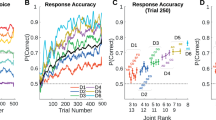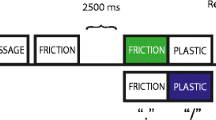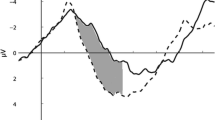Abstract
The SNARC effect, consisting of a systematic association between numbers and lateralized response, reflects the mental representation of magnitude along a left-to-right mental number line (Dehaene et al. in J Exp Psychol 122:371–396, 1993). Critically, this effect has been reported in the classification of overlearned non-numerical sequences such as letters, days and months (Gevers et al. in Cognition 87:B87–B95, 2003 and Cortex 40:171–172, 2004) suggesting that ordinal, rather than magnitude information, is critical for spatial coding. This study tests the hypothesis of an oriented spatial representation as the privileged way of mentally organizing serial information, by looking for stimulus–response compatibility effects in the processing of a newly acquired arbitrary sequence. Here we report an association between ordinal position of the items and spatial response preference for both order-relevant and order-irrelevant tasks. These results suggest that any ordered information, even when order is not intrinsically relevant to it, is spontaneously mapped in the representational space. This spatial representation is likely to acquire a left-to-right orientation, at least in western cultures.


Similar content being viewed by others
Notes
The current study was carried out before the publication of the Van Opstal et al. study.
References
Atkinson RC, Shiffrin RM (1968) The psychology of learning and motivation. In: Spence KW (ed) Advances in research and theory. Academic, New York, pp 89–195
Damian MF (2004) Asymmetries in the processing of Arabic digits and number words. Mem Cogn 32:164–171
Dehaene S, Bossini S, Giraux P (1993) The mental representation of parity and number magnitude. J Exp Psychol Gen 122:371–396
Dehaene S, Piazza M, Pinel P, Cohen L (2003) Three parietal circuits of number processing. Cogn Neuropsychol 20:487–506
Dodd MD, Van der Stigchel S, Leghari MA, Fung G, Kingstone A (2008) Attentional SNARC: there’s something special about numbers (let us count the ways). Cognition 108:810–818
Fias W, Brysbaert M, Geypens F, d’Ydewalle G (1996) The importance of magnitude information in numerical processing: evidence from the SNARC effect. Math Cogn 2:95–110
Fias W, Reynvoet B, Brysbaert M (2001) Are Arabic numerals processed as picture in a Stroop interference task? Psychol Res 65:242–249
Fias W, Lammertyn J, Caessens B, Orban GA (2007) Processing of abstract ordinal knowledge in the horizontal segment of the intraparietal sulcus. J Neurosci 27:8952–8956
Fischer MH (2006) The future for SNARC could be stark. Cortex 42:1066–1068
Fischer MH, Castel AD, Dodd MD, Pratt J (2003) Perceiving numbers causes spatial shifts of attention. Nat Neurosci 6:555–556
Franklin MS, Jonides J, Smith EE (2009) Processing of order information for numbers and months. Mem Cogn 37(5):644–654
Gevers W, Reynvoet B, Fias W (2003) The mental representation of ordinal sequences is spatially organized. Cognition 87:B87–B95
Gevers W, Reynvoet B, Fias W (2004) The mental representation of ordinal sequences is spatially organized. Evidence from days of the week. Cortex 40:171–172
Gevers W, Verguts T, Reynvoet B, Caessens B, Fias W (2006) Numbers and space: a computational model of the SNARC effect. J Exp Psychol Hum Percept Perform 32:32–44
Glaser WR (1992) Picture naming. Cognition 42:61–105
Ishihara M, Keller PE, Rossetti Y, Prinz W (2008) Horizontal spatial representations of time: evidence for the STEARC effect. Cortex 44:454–461
Kosslyn SM, Koenig O, Barrett A, Cave CB (1989) Evidence for two types of spatial representations: hemispheric specialization for categorical and coordinate relations. J Exp Psychol Hum Percept Perform 15(4):723–735
Lorch RF Jr, Myers JL (1990) Regression analyses of repeated measures data in cognition research. J Exp Psychol Learn Mem Cogn 16:149–157
Lotto L, Dell’Acqua R, Job R (2001) Le figure PD/DPSS. Norme di accordo sul nome, tipicità, familiarità, età di acquisizione e tempi di denominazione per 266 figure. G Ital Psicol 28:193–207
Marshuetz C, Smith EE, Jonides J, DeGutis J, Chenevert TL (2000) Order information in working memory: fMRI evidence for parietal and prefrontal mechanisms. J Cogn Neurosci 12(Suppl 2):130–144
Moyer RS, Landauer TK (1967) Time required for judgements of numerical inequality. Nature 215:1519–1520
Müller D, Schwarz W (2007) Is there an internal association of numbers to hands? The task set influences the nature of the SNARC effect. Mem Cogn 35(5):1151–1161
Nuerk HC, Iversen W, Willmes K (2004) Notational modulation of the SNARC and the MARC (linguistic markedness of response codes) effect. Q J Exp Psychol 57A(5):835–863
Proctor RW, Cho YS (2006) Polarity correspondence: a general principle for performance of speeded binary classification tasks. Psychol Bull 132:416–442
Restle F (1970) Speed of adding and comparing numbers. J Exp Psychol 95:437–444
Rusconi E, Kwan B, Giordano BL, Umiltà C, Butterworth B (2006) Spatial representation of pitch height: the SMARC effect. Cognition 99:113–129
Shaki S, Fischer MH (2008) Reading space into numbers—a cross-linguistic comparison of the SNARC effect. Cognition 108:590–599
Shaki S, Fischer MH, Petrusic WM (2009) Reading habits for both words and numbers contribute to the SNARC effect. Psychon Bull Rev 16(2):328–331
Turconi E, Jemel B, Rossion B, Seron X (2004) Electrophysiological evidence for differential processing of numerical quantity and order in humans. Cogn Brain Res 21:22–38
Van Opstal F, Fias W, Peigneux P, Verguts T (2009) The neural representation of extensively trained ordered sequences. Neuroimage 47:367–375
Zebian S (2005) Linkages between number concepts, spatial thinking, and directionality of writing: the SNARC effect and the reverse SNARC effect in English and Arabic monoliterates, biliterates, and illiterate Arabic speakers. J Cogn Cult 5:165–190
Zorzi M, Priftis K, Meneghello F, Marenzi R, Umiltà C (2006) The spatial representation of numerical and non-numerical sequences: evidence from neglect. Neuropsychologia 44:1061–1067
Acknowledgment
This work was supported by a research grant from the University of Milano-Bicocca (FAR 2008) to LG and a Postodoctoral Fellowship from the Spanish Ministry of Education to MDdH.
Author information
Authors and Affiliations
Corresponding author
Rights and permissions
About this article
Cite this article
Previtali, P., de Hevia, M.D. & Girelli, L. Placing order in space: the SNARC effect in serial learning. Exp Brain Res 201, 599–605 (2010). https://doi.org/10.1007/s00221-009-2063-3
Received:
Accepted:
Published:
Issue Date:
DOI: https://doi.org/10.1007/s00221-009-2063-3




